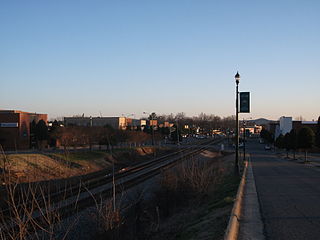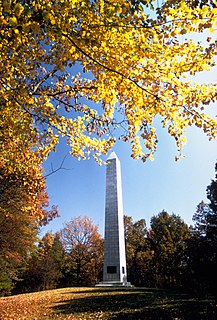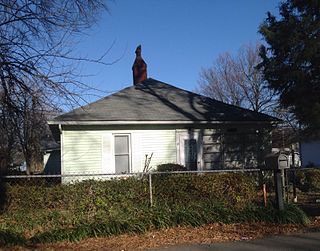
Shelby is a city in and the county seat of Cleveland County, North Carolina, United States. It lies near the western edge of the Charlotte combined statistical area. The population was 20,323 at the 2010 census.

Kings Mountain is a small suburban city within the Charlotte metropolitan area in Cleveland and Gaston counties, North Carolina, United States. Most of the city is in Cleveland County, with a small eastern portion in Gaston County. The population was 10,296 at the 2010 census. During the Revolutionary War, Patriot militia defeated Loyalist militia in the Battle of Kings Mountain.

Myers Park is a neighborhood and historic district in Charlotte, North Carolina, United States.

Kings Mountain National Military Park is a National Military Park near Blacksburg, South Carolina, along the North Carolina/South Carolina border. The park commemorates the Battle of Kings Mountain, a pivotal and significant victory by American Patriots over American Loyalists during the Southern Campaign of the Revolutionary War. It was listed on the National Register of Historic Places in 1996. Thomas Jefferson considered the battle "The turn of the tide of success."

The John C. Campbell Folk School, also referred to as "The Folk School", is located in Brasstown, North Carolina, along the Cherokee County and Clay line. The school was founded to nurture and preserve the folk arts of the Appalachian Mountains. It is a non-profit adult educational organization based on non-competitive learning. Founded in 1925, the Folk School's motto is "I sing behind the plow".

This is a list of the properties and historic districts in each of the 46 counties of South Carolina that are designated National Register of Historic Places.

The Sycamore Shoals of the Watauga River, usually shortened to Sycamore Shoals, is a rocky stretch of river rapids along the Watauga River in Elizabethton, Tennessee. Archeological excavations have found Native Americans lived near the shoals since prehistoric times, and Cherokees gathered there. As Europeans began settling the Trans-Appalachian frontier, the shoals proved strategic militarily, as well as shaped the economies of Tennessee and Kentucky. Today, the shoals are protected as a National Historic Landmark and are maintained as part of Sycamore Shoals State Historic Park.
West End Historic District, or Westend Historic District, and variations with Commercial or Old or other, may refer to:

In the law regulating historic districts in the United States, a contributing property or contributing resource is any building, object, or structure which adds to the historical integrity or architectural qualities that make the historic district significant. Government agencies, at the state, national, and local level in the United States, have differing definitions of what constitutes a contributing property but there are common characteristics. Local laws often regulate the changes that can be made to contributing structures within designated historic districts. The first local ordinances dealing with the alteration of buildings within historic districts was passed in Charleston, South Carolina in 1931.

Kings Mountain State Park is a South Carolina state park located in the Piedmont region of South Carolina. It is situated in York County near the city of Blacksburg, about 40 miles (64 km) southwest of Charlotte, North Carolina near Interstate 85.

College Hill is a neighborhood in the west central section of the United States city of Greensboro, North Carolina. College Hill was Greensboro's first neighborhood.
This is an incomplete list of historic properties and districts at United States colleges and universities that are listed on the National Register of Historic Places (NRHP). This includes National Historic Landmarks (NHLs) and other National Register of Historic Places listings. It includes listings at current and former educational institutions.

Edenton Historic District is a national historic district located at Edenton, Chowan County, North Carolina. The district encompasses 342 contributing buildings, 4 contributing sites, and 3 contributing structures. It includes several buildings that are individually listed on the National Register. The Lane House, possibly the oldest surviving house in North Carolina, is owned by Steve and Linda Lane and is located within the district. Also located in the district are the Dixon-Powell House, William Leary House, and Louis Ziegler House designed by architect George Franklin Barber.

Halifax Historic District is a national historic district located at Halifax, Halifax County, North Carolina, US that was listed on the National Register of Historic Places in 1970. It includes several buildings that are individually listed on the National Register. Halifax was the site of the signing of the Halifax Resolves on April 12, 1776, a set of resolutions of the North Carolina Provincial Congress which led to the United States Declaration of Independence gaining the support of North Carolina's delegates to the Second Continental Congress in that year.

Too-Cowee, was an important historic Cherokee town located near the Little Tennessee River north of present-day Franklin, North Carolina. It also had a prehistoric platform mound and earlier village built by ancestral peoples. As their expression of public architecture, the Cherokee built a townhouse on top of the mound. It was the place for their community gatherings in their highly decentralized society. The name translates to "pig fat" in English. British traders and colonists referred to Cowee as one of the Cherokee Middle Towns along this river; they defined geographic groupings based in relation to their coastal settlements, such as Charlestown, South Carolina.

Black Mountain Downtown Historic District is a national historic district located at Black Mountain, Buncombe County, North Carolina. The district encompasses 56 contributing buildings and 1 contributing structure in the central business district of Black Mountain. The district includes a variety of late-19th and early-20th century commercial and institutional buildings in the Commercial Style, American Craftsman, Classical Revival, Art Deco and Art Moderne. Notable buildings include the George Stepp House (1907), Black Mountain Depot (1909), firehouse (1921) designed by Richard Sharp Smith, town hall (1927), Kaltman Building (1928), and Pure Oil Service Station.

Cape Lookout Village Historic District is a national historic district located near Core Banks, Carteret County, North Carolina. It encompasses 20 contributing buildings 1 contributing site, and 6 contributing structures in Cape Lookout Village. The buildings include notable examples of Queen Anne and Bungalow / American Craftsman style architecture. The district includes two government complexes: the Cape Lookout Lighthouse Station and the Cape Lookout Coast Guard Station. In addition, 14 buildings, a long dock, and the circulation network, as well as the landscape in which these lie, compose the district. The buildings include the Life Saving Station (1888) and Boathouse, the Keeper's Quarters (1907), Luther Guthrie House, Gaskill-Guthrie House, Seifert-Davis House, Baker-Holderness House, the Bryant House, and the Carrie Arendell Davis House.

Central School Historic District is a national historic district located at Kings Mountain, Cleveland County, North Carolina. It encompasses 52 contributing buildings and 4 contributing structures in a residential section of Kings Mountain. The houses date between about 1870 and 1950, and include representative examples of the Second Empire and Queen Anne architectural styles. Notable nonresidential buildings are the Second Southern Railway Depot (1925), St. Matthew's Lutheran Church, First Presbyterian Church (1936), and Central·High School (1933).

Margrace Mill Village Historic District is a national historic district located at Kings Mountain, Cleveland County, North Carolina. It encompasses 57 contributing buildings in a residential section of Kings Mountain. The houses date between about 1919 and 1956, and characterized by one-story frame mill houses. All of the principal resources in the district were erected by the Neisler family textile company and housed employees of the nearby Margrace and Patricia mills. Notable nonresidential buildings are the Margrace Mill Clubhouse and Margrace Mill Company Store.
West End Historic District is a national historic district located at Winston-Salem, Forsyth County, North Carolina. The district encompasses 508 contributing buildings and 7 contributing structures, in a predominantly residential section of Winston-Salem. It was a planned picturesque streetcar suburb developed at the turn of the 20th century. The buildings date from about 1887 to 1930, and include notable examples of Classical Revival, Colonial Revival, Queen Anne, and Bungalow / American Craftsman style architecture. Located in the district are the separately listed H. D. Poindexter Houses and Zevely House. Other notable buildings include the St. Paul's Episcopal Church (1928-1929) designed by Ralph Adams Cram, Augsburg Lutheran Church (1926), Friends Meeting House (1927), the First Church of Christ, Scientist (1924), and Joyner's West End Grocery.























